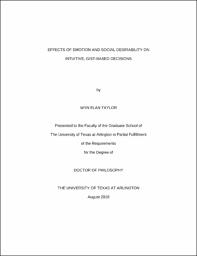
ATTENTION: The works hosted here are being migrated to a new repository that will consolidate resources, improve discoverability, and better show UTA's research impact on the global community. We will update authors as the migration progresses. Please see MavMatrix for more information.
Show simple item record
| dc.contributor.advisor | Ickes, William | |
| dc.contributor.advisor | Levine, Daniel S. | |
| dc.creator | Taylor, Wyn E. | |
| dc.date.accessioned | 2019-02-27T02:22:25Z | |
| dc.date.available | 2019-02-27T02:22:25Z | |
| dc.date.created | 2018-08 | |
| dc.date.issued | 2018-08-31 | |
| dc.date.submitted | August 2018 | |
| dc.identifier.uri | http://hdl.handle.net/10106/27833 | |
| dc.description.abstract | People often make what appear to be inconsistent, irrational choice preference shifts from sure-to-risky (or from risky-to-sure) options depending on how the choices are framed—this is a form of decision bias called the framing effect. Given numerically identical outcome options, a consistent preference for risky choices or for sure choices is viewed in decision theory as a rational choice. Fuzzy Trace Theory suggests that framing effects are the result of gist processes. However, social desirability characteristics of the choices and individuals’ concern for social approval could explain framing effects. The current study compared susceptibility to the framing effect in three groups: 176 pre-college adults, 223 post-college adults, and 50 firefighters. Age ranged from 18 to over 56 years, with 60% of the sample female. It examined the effects of emotion on, and the amount of information presented explicitly in, choices, as well as possible relationships between the social desirability characteristics of the decision task items, susceptibility to the framing effect, and need for social approval (concern for social desirability). High, neutral, and low emotion manipulation conditions were expected to increase and decrease gist and verbatim processing and thereby affect susceptibility to the framing effect. However, the emotion induction procedure was not effective, and no significant differences were found between groups. Results for the three truncation versions were significant. As expected, the least amount of framing effect was seen in the non-zero-complement version, whereas the highest amount was seen in the zero-complement version, with the complete version in the middle. This provided support for the Fuzzy Trace processing view of the framing effect. A separate social desirability rating study showed significant results at the decision choice item level; however, contrary to expectation, individuals high in need for social approval were not more susceptible to the framing effect. The real strength of this research was that it is the first study to examine the social desirability characteristics of a set of decision items commonly used to measure framing effects. More research is needed to determine if there are causal relationships between social desirability characteristics choice items and framing effects. | |
| dc.format.mimetype | application/pdf | |
| dc.language.iso | en_US | |
| dc.subject | Intuitive decisions | |
| dc.subject | Decision making | |
| dc.subject | Fuzzy trace theory | |
| dc.subject | Framing effects | |
| dc.subject | Gist processing | |
| dc.subject | Intuition | |
| dc.subject | Social desirability | |
| dc.subject | Firefighters | |
| dc.title | Effects of Emotion and Social Desirability on Intuitive, Gist-Based Decisions | |
| dc.type | Thesis | |
| dc.degree.department | Psychology | |
| dc.degree.name | Doctor of Philosophy in Psychology | |
| dc.date.updated | 2019-02-27T02:22:26Z | |
| thesis.degree.department | Psychology | |
| thesis.degree.grantor | The University of Texas at Arlington | |
| thesis.degree.level | Doctoral | |
| thesis.degree.name | Doctor of Philosophy in Psychology | |
| dc.type.material | text | |
| dc.creator.orcid | 0000-0002-4591-2201 | |
Files in this item
- Name:
- TAYLOR-DISSERTATION-2018.pdf
- Size:
- 825.8Kb
- Format:
- PDF
This item appears in the following Collection(s)
Show simple item record


